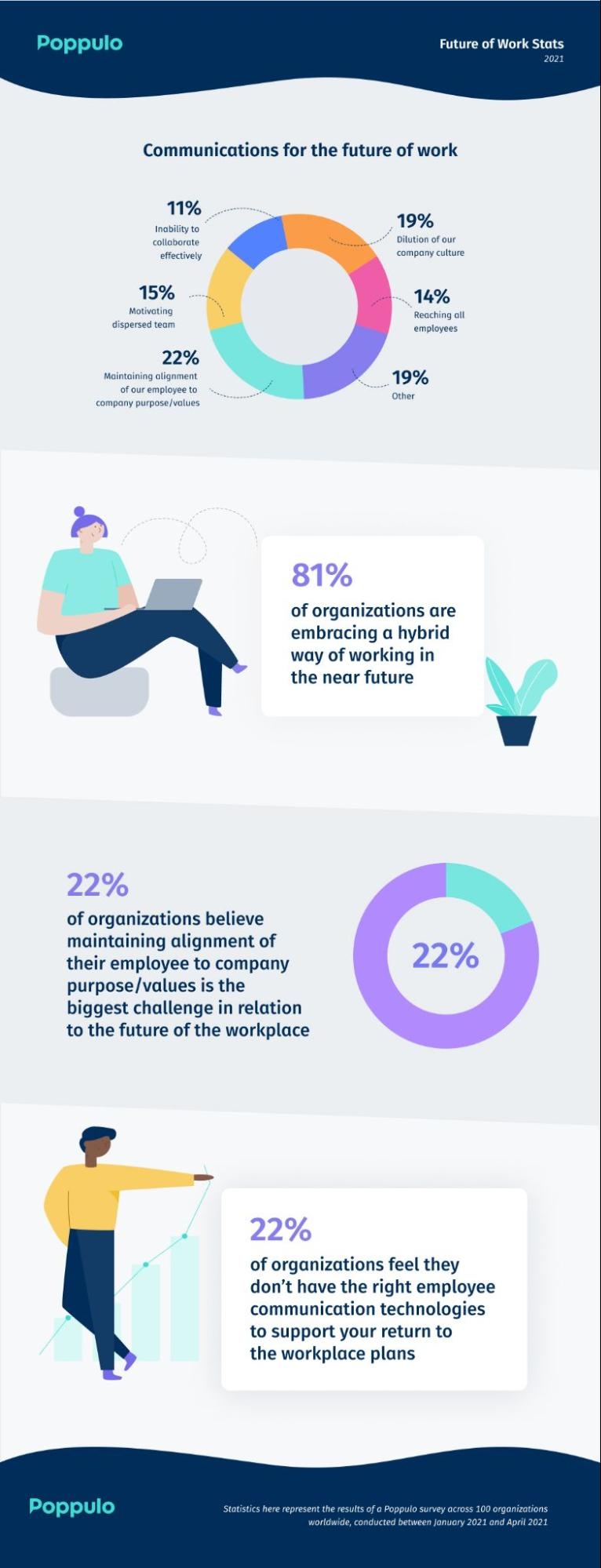— July 26th, 2021
What is a hybrid workplace model?
We’re at a moment of historic change in the world of work. Over the past year, organizations have implemented a variety of hybrid working models. A hybrid workplace supports remote and in-office working. Employees can split their time between the office and home environment.
This flexible approach to work will require a coordinated approach, including clear communications and smart use of technology, if it is to succeed. . But according to McKinsey, 68% of companies haven’t communicated a clear vision for post-pandemic work, with serious negative consequences on employee productivity.
In contrast, those organizations that have effectively communicated a plan are seeing outsized benefits — their employees are five times more productive because they have the clarity and confidence that vision provides.
What does hybrid working look like?
As the world of work continues to be in flux, organizations are faced with a number of challenges. At Poppulo, we surveyed over 100 organizations worldwide and found that 22% believe maintaining alignment of the employee to organization purpose will be the biggest challenge in facing the future of work. Leaders fear a disconnect between company goals and employee mindsets as the new ways of working become more and more complex.
Simply reaching employees is more challenging than ever before; 22% of organizations believe they don’t have the correct technologies to reach and communicate with their employees in this new world of work.
As communicators search for the correct channel mix and strategy to engage their people, many are hindered by a tech stack that does not meet the needs of this changed workplace.
Engaging with a distributed workforce, which combines remote and in-office workers, requires an omnichannel platform where workers can consume communications using the channel that best suits their location on a particular day.
In this distributed workplace, where employees are not fully based in the office, leaders fear the dilution of company culture. 19% of the organizations we surveyed believe this will be the biggest challenge with the future of work.
Colleague relationships, onboarding, team collaboration, overall motivation, and employee experience appear to be at the forefront of many people’s concerns.
Benefits of hybrid working?
The flexibility that a hybrid working model offers has become an attractive option for workers. And for large organizations intent on reducing employee churn and ensuring their competitiveness when hiring key staff, embracing a hybrid working model is increasingly important. . 81% of organizations we surveyed are embracing a hybrid model in the near future.
In a recent Accenture report, 83% of 9,326 workers surveyed say they prefer a hybrid model — in which they can work remotely at least 25% of the time.
A recent study by Stanford of 16,000 workers over 9 months found that working from home increased productivity by 13%. This increase in performance was due to more calls per minute attributed to a quieter, more convenient working environment and working more minutes per shift because of fewer breaks and sick days.
Many leaders who once feared the shift to a more distributed work environment have been persuaded by the results. Employees who would have feared the separation from the office environment have embraced the change over time and now are looking forward to a new way of working.

Certainly, organizations globally are trying to unravel the true impact of the acceleration of hybrid working. The employee life cycle has never been so unclear. Traditionally, we describe the 6 stages of an employee and company relationship as Attraction, Recruitment, Onboarding, Development, Retention, and Separation.
Human Resource leaders develop strategies to optimize areas of this cycle to improve overall employee experience and retain talent at their organizations. The future of work will no doubt have a large impact on success.
The impact on recruitment is severe, 43% of HR professionals cited “competition from other employers” as the top reason they’re struggling to hire the right employees (SHRM). How organizations display and communicate their approach to the future of work is key to attracting talent in today’s environment. Organizations who are embracing very flexible or fully remote working are boarding their reach in regards to recruitment thus creating a more competitive market.
Employee connection, alignment, and clarity of communications will be imperative in retaining employees. Progressive employees will strive for clear structures and working conditions that suit their requirements.
Without a doubt, the employee life cycle has never been so complex or challenged. The increased variety in working models is causing churn within employee bases and focusing the spotlight on clarity from leaders.
Benefits of working from home?
Many of us have embraced the hybrid working life and we’ve learned a lot from the experience. We’ve become better project managers and we’ve seen the benefits of a healthy work-life balance. Some of the main benefits include:
- Executing remedial household tasks during coffee breaks
- Achieving our step counts during lunch break
- Securing additional time to spend with family and loved ones
- Decreased the need to join morning traffic jams and less car pollution as a result
There are endless impacts from this historic change in the way we work but many are finding several positives amongst this new era.
What is a hybrid work schedule?
We asked over 250 professionals on Linkedin, what is their preferred schedule regarding the future of work. 60% selected 0-25% of the time in the office and only 4% selected 100%. This begs the question, is the idea of the office as a full-time workplace a permanent thing of the past?
Certainly, today’s generation of workers is organizing the work schedule to align with their needs and values. Employees now increasingly demand the flexibility to select their own schedules. Organizations will have a lot to comprehend when it comes to supporting their employees through the next few months and stages of this historic change. However, initiating clear and focused levels of communication will be key to success.
